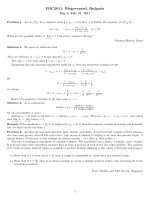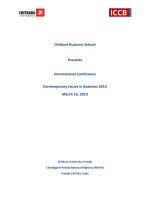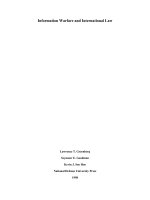information hiding 13th international conference, ih 2011, prague, czech republic, may 18-20, 2011 revised selected papers
Bạn đang xem bản rút gọn của tài liệu. Xem và tải ngay bản đầy đủ của tài liệu tại đây (5.45 MB, 358 trang )
Lecture Notes in Computer Science 6958
Commenced Publication in 1973
Founding and Former Series Editors:
Gerhard Goos, Juris Hartmanis, and Jan van Leeuwen
Editorial Board
David Hutchison
Lancaster University, UK
Takeo Kanade
Carnegie Mellon University, Pittsburgh, PA, USA
Josef Kittler
University of Surrey, Guildford, UK
Jon M. Kleinberg
Cornell University, Ithaca, NY, USA
Alfred Kobsa
University of California, Irvine, CA, USA
Friedemann Mattern
ETH Zurich, Switzerland
John C. Mitchell
Stanford University, CA, USA
Moni Naor
Weizmann Institute of Science, Rehovot, Israel
Oscar Nierstrasz
University of Bern, Switzerland
C. Pandu Rangan
Indian Institute of Technology, Madras, India
Bernhard Steffen
TU Dortmund University, Germany
Madhu Sudan
Microsoft Research, Cambridge, MA, USA
Demetri Terzopoulos
University of California, Los Angeles, CA, USA
Doug Tygar
University of California, Berkeley, CA, USA
Gerhard Weikum
Max Planck Institute for Informatics, Saarbruecken, Germany
Tomáš Filler Tomáš Pevný
Scott Craver Andrew Ker (Eds.)
Information Hiding
13th International Conference, IH 2011
Prague, Czech Republic, May 18-20, 2011
Revised Selected Papers
13
Volume Editors
Tomáš Filler
Digimarc Corporation
9405 Gemini Drive
Beaverton, OR, 97008, USA
E-mail: tomas.fi
Tomáš Pevný
Czech Technical University
Faculty of Electrical Engineering, Department of Cybernetics
Karlovo namesti 13
121 35 Prague 2, Czech Republic
E-mail:
Scott Craver
SUNY Binghamton
T. J. Watson School, Department of Electrical and Computer Engineering
Binghamton, NY 13902, USA
E-mail:
Andrew Ker
University of Oxford, Department of Computer Science
Wolfson Building, Parks Road
Oxford OX1 3QD, UK
E-mail:
ISSN 0302-9743 e-ISSN 1611-3349
ISBN 978-3-642-24177-2 e-ISBN 978-3-642-24178-9
DOI 10.1007/978-3-642-24178-9
Springer Heidelberg Dordrecht London New York
Library of Congress Control Number: 2011936237
CR Subject Classification (1998): E.3, K.6.5, D.4.6, E.4, H.5.1, I.4
LNCS Sublibrary: SL 4 – Security and Cryptology
© Springer-Verlag Berlin Heidelberg 2011
This work is subject to copyright. All rights are reserved, whether the whole or part of the material is
concerned, specifically the rights of translation, reprinting, re-use of illustrations, recitation, broadcasting,
reproduction on microfilms or in any other way, and storage in data banks. Duplication of this publication
or parts thereof is permitted only under the provisions of the German Copyright Law of September 9, 1965,
in its current version, and permission for use must always be obtained from Springer. Violations are liable
to prosecution under the German Copyright Law.
The use of general descriptive names, registered names, trademarks, etc. in this publication does not imply,
even in the absence of a specific statement, that such names are exempt from the relevant protective laws
and regulations and therefore free for general use.
Typesetting: Camera-ready by author, data conversion by Scientific Publishing Services, Chennai, India
Printed on acid-free paper
Springer is part of Springer Science+Business Media (www.springer.com)
Preface
The International Hiding Conference was founded 15 years ago, with the first
conference held in Cambridge, UK, in 1996. Since then, the conference locations
have alternated between Europe and North America. In 2011, during May 18–20,
we had the pleasure of hosting the 13th Information Hiding Conference in
Prague, Czech Republic. The 60 attendees had the opportunity to enjoy Prague
in springtime as well as inspiring presentations and fruitfull discussions with
colleagues.
The International Hiding Conference has a tradition in attracting researchers
from many closely related fields including digital watermarking, steganography
and steganalysis, anonymity and privacy, covert and subliminal channels, finger-
printing and embedding codes, multimedia forensics and counter-forensics, as
well as theoretical aspects of information hiding and detection. In 2011, the Pro-
gram Committee reviewed 69 papers, using a double-blind system with at least
3 reviewers per paper. Then, each paper was carefully discussed until consensus
was reached, leading to 23 accepted papers (33% acceptance rate), all published
in these proceedings.
The invited speaker was Bernhard Sch¨olkopf, who presented his thoughts on
why kernel methods (and support vector machines in particular) are so popular
and where they are heading. He also discussed some recent developments in two-
sample and independence testing as well as applications in different domains.
At this point, we would like to thank everyone, who helped to organize
the conference, namely, Jakub Havr´anek from the Mediaform agency and B´ara
Jen´ıkov´a from CVUT in Prague. We also wish to thank the following companies
and agencies for their contribution to the success of this conference: European
Office of Aerospace Research and Development, Air Force Office of Scientific
Research, United States Air Force Research Laboratory (www.london.af.mil),
the Office of Naval Research Global (www.onr.navy.mil), Digimarc Corporation
(www.digimarc.com), Technicolor (www.technicolor.com), and organizers of IH
2008 in santa Barbara, CA, USA. Without their generous financial support, the
organization would have been very difficult.
July 2011 Tom´aˇs Filler
Tom´aˇsPevn´y
Scott Craver
Andrew Ker
Organization
13th Information Hiding Conference
May 18–20, 2011, Prague (Czech Republic)
General Chair
Tom´aˇsPevn´y Czech Technical University, Czech Republic
Program Chairs
Tom´aˇs Filler SUNY Binghamton / Digimarc Corp., USA
Scott Craver SUNY Binghamton, USA
Andrew Ker University of Oxford, UK
Program Committee
Ross Anderson University of Cambridge, UK
Mauro Barni Universit`a di Siena, Italy
Patrick Bas CNRS, France
Rainer B¨ohme University of M¨unster, Germany
Fran¸ois Cayre GIPSA-lab/Grenoble INP, France
Ee-Chien Chang National University of Singapore, Singapore
Christian Collberg University of Arizona, USA
Ingemar J. Cox University College London, UK
George Danezis Microsoft Research Cambridge, UK
Gwena¨el Do¨err Technicolor, France
Jessica Fridrich SUNY Binghamton, USA
Teddy Furon INRIA, France
Neil F. Johnson Booz Allen Hamilton and JJTC, USA
Stefan Katzenbeisser TU Darmstadt, Germany
Darko Kirovski Microsoft Research, USA
John McHugh University of North Carolina, USA and
RedJack, LLC.
Ira S. Moskowitz Naval Research Laboratory, USA
Ahmad-Reza Sadeghi Ruhr-Universit¨at Bochum, Germany
Rei Safavi-Naini University of Calgary, Canada
Phil Sallee Booz Allen Hamilton, USA
Berry Schoenmakers TU Eindhoven, The Netherlands
Kaushal Solanki Mayachitra Inc., USA
Kenneth Sullivan Mayachitra Inc., USA
Paul Syverson Naval Research Laboratory, USA
VIII Organization
Local Organization
Jakub Havr´anek Mediaform, Czech Republic
Barbora Jen´ıkov´a Czech Technical University, Czech Republic
External Reviewer
Boris
ˇ
Skori´c Eindhoven University of Technology,
The Netherlands
Sponsoring Institutions
European Office of Aerospace Research and Development
Office of Naval Research
Digimarc Corporation, USA
Technicolor, France
Table of Contents
Fingerprinting
Asymptotic Fingerprinting Capacity for Non-binary Alphabets 1
Dion Boesten and Boris
ˇ
Skori´c
Asymptotically False-Positive-Maximizing Attack on Non-binary
Tardos Codes 14
Antonino Simone and Boris
ˇ
Skori´c
Towards Joint Tardos Decoding: The ‘Don Quixote’ Algorithm 28
Peter Meerwald and Teddy Furon
An Asymmetric Fingerprinting Scheme Based on Tardos Codes 43
Ana Charpentier, Caroline Fontaine, Teddy Furon, and Ingemar Cox
Special Session on BOSS Contest
“Break Our Steganographic System”— The Ins and Outs of Organizing
BOSS 59
Patrick Bas, Tom´aˇs Filler, and Tom´aˇs Pevn´y
A New Methodology in Steganalysis : Breaking Highly Undetectable
Steganograpy (HUGO) 71
Gokhan Gul and Fatih Kurugollu
Breaking HUGO – The Process Discovery 85
Jessica Fridrich, Jan Kodovsk´y, Vojtˇech Holub, and Miroslav Goljan
Steganalysis of Content-Adaptive Steganography in Spatial Domain 102
Jessica Fridrich, Jan Kodovsk´y, Vojtˇech Holub, and Miroslav Goljan
Anonymity and Privacy
I Have a DREAM! (DiffeRentially privatE smArt Metering) 118
Gergely
´
Acs and Claude Castelluccia
Anonymity Attacks on Mix Systems: A Formal Analysis 133
Sami Zhioua
Differentially Private Billing with Rebates 148
George Danezis, Markulf Kohlweiss, and Alfredo Rial
X Table of Contents
Steganography and Steganalysis
Statistical Decision Methods in Hidden Information Detection 163
Cathel Zitzmann, R´emi Cogranne, Florent Retraint, Igor Nikiforov,
Lionel Fillatre, and Philippe Cornu
A Cover Image Model for Reliable Steganalysis 178
R´emi Cogranne, Cathel Zitzmann, Lionel Fillatre, Florent Retraint,
Igor Nikiforov, and Philippe Cornu
Video Steganography with Perturbed Motion Estimation 193
Yun Cao, Xianfeng Zhao, Dengguo Feng, and Rennong Sheng
Watermarking
Soft-SCS: Improving the Security and Robustness of the Scalar-Costa-
Scheme by Optimal Distribution Matching 208
Patrick Bas
Improving Tonality Measures for Audio Watermarking 223
Michael Arnold, Xiao-Ming Chen, Peter G. Baum, and
Gwena¨el Do¨err
Watermarking as a Means to Enhance Biometric Systems: A Critical
Survey 238
Jutta H¨ammerle-Uhl, Karl Raab, and Andreas Uhl
Capacity-Approaching Codes for Reversible Data Hiding 255
Weiming Zhang, Biao Chen, and Nenghai Yu
Digital Rights Management and Digital Forensics
Code Obfuscation against Static and Dynamic Reverse Engineering 270
Sebastian Schrittwieser and Stefan Katzenbeisser
Countering Counter-Forensics: The Case of JPEG Compression 285
ShiYue Lai and Rainer B¨ohme
Data Hiding in Unusual Content
Stegobot: A Covert Social Network Botnet 299
Shishir Nagaraja, Amir Houmansadr, Pratch Piyawongwisal,
Vijit Singh, Pragya Agarwal, and Nikita Borisov
Table of Contents XI
CoCo: Coding-Based Covert Timing Channels for Network Flows 314
Amir Houmansadr and Nikita Borisov
LinL:Lostinn-bestList 329
Peng Meng, Yun-Qing Shi, Liusheng Huang, Zhili Chen,
Wei Yang, and Abdelrahman Desoky
Author Index 343
Asymptotic Fingerprinting Capacity
for Non-binary Alphabets
Dion Boesten and Boris
ˇ
Skori´c
Eindhoven University of Technology
Abstract. We compute the channel capacity of non-binary fingerprint-
ing under the Marking Assumption, in the limit of large coalition size c.
The solution for the binary case was found by Huang and Moulin. They
showed that asymptotically, the capacity is 1/(c
2
2 ln 2), the interleav-
ing attack is optimal and the arcsine distribution is the optimal bias
distribution.
In this paper we prove that the asymptotic capacity for general al-
phabet size q is (q − 1)/(c
2
2lnq). Our proof technique does not reveal
the optimal attack or bias distribution. The fact that the capacity is
an increasing function of q shows that there is a real gain in going to
non-binary alphabets.
1 Introduction
1.1 Collusion Resistant Watermarking
Watermarking provides a means for tracing the origin and distribution of digital
data. Before distribution of digital content, the content is modified by applying
an imperceptible watermark (WM), embedded using a watermarking algorithm.
Once an unauthorized copy of the content is found, it is possible to trace those
users who participated in its creation. This process is known as ‘forensic wa-
termarking’. Reliable tracing requires resilience against attacks that aim to re-
move the WM. Collusion attacks, where several users cooperate, are a particular
threat: differences between their versions of the content tell them where the WM
is located. Coding theory has produced a number of collusion-resistant codes.
The resulting system has two layers: The coding layer determines which message
to embed and protects against collusion attacks. The underlying watermarking
layer hides symbols of the code in segments
1
of the content. The interface be-
tween the layers is usually specified in terms of the Marking Assumption,which
states that the colluders are able to perform modifications only in those seg-
ments where they received different WMs. These segments are called detectable
positions.
Many collusion resistant codes have been proposed in the literature. Most
notable is the Tardos code [13], which achieves the asymptotically optimal pro-
portionality m ∝ c
2
,withm the code length. Tardos introduced a two-step
1
The ‘segments’ are defined in a very broad sense. They may be coefficients in any
representation of the content (codec).
T. Filler et al. (Eds.): IH 2011, LNCS 6958, pp. 1–13, 2011.
c
Springer-Verlag Berlin Heidelberg 2011
2D.BoestenandB.
ˇ
Skori´c
stochastic procedure for generating binary codewords: (i) For each segment a
bias is randomly drawn from some distribution F . (ii) For each user indepen-
dently, a 0 or 1 is randomly drawn for each segment using the bias for that
segment. This construction was generalized to larger alphabets in [14].
1.2 Related Work: Channel Capacity
In the original Tardos scheme [13] and many later improvements and generali-
sations (e.g. [16,14,3,10,9,4,15,17]), users are found to be innocent or guilty via
an ‘accusation sum’, a sum of weighted per-segment contributions, computed
for each user separately. The discussion of achievable performance was greatly
helped by the onset of an information-theoretic treatment of anti-collusion codes.
The whole class of bias-based codes can be treated as a maximin game between
the watermarker and the colluders [2,8,7], independently played for each seg-
ment, where the payoff function is the mutual information between the symbols
x
1
, ,x
c
handed to the colluders and the symbol y produced by them. In each
segment (i.e. for each bias) the colluders try to minimize the payoff function
using an attack strategy that depends on the (frequencies of the) received sym-
bols x
1
, ,x
c
. The watermarker tries to maximize the average payoff over the
segments by setting the bias distribution F .
It was conjectured [7] that the binary capacity is asymptotically given by
1/(c
2
2 ln 2). The conjecture was proved in [1,6]. Amiri and Tardos [1] developed
an accusation scheme (for the binary case) where candidate coalitions get a score
related to the mutual information between their symbols and y.Thisscheme
achieves capacity but is computationally very expensive. Huang and Moulin [6]
proved for the large-c limit (in the binary case) that the interleaving attack and
Tardos’s arcsine distribution are optimal.
1.3 Contributions and O utline
We prove for alphabet size q that the asymptotic fingerprinting capacity is
q−1
c
2
2lnq
.
Our proof makes use of the fact that the value of the maximin game can be
found by considering the minimax game instead (i.e. in the reverse order). This
proof does not reveal the asymptotically optimal collusion strategy and bias
distribution of the maximin game.
In Section 2 we introduce notation, discuss the information-theoretic payoff
game and present lemmas that will be used later. In Section 3 we analyze the
properties of the payoff function in the large-c limit. We solve the minimax game
in Section 4. In Section 5 we discuss the benefits of larger alphabets.
2 Preliminaries
2.1 Notation
We use capital letters to represent random variables, and lowercase letters to
their realizations. Vectors are denoted in boldface and the components of a
Asymptotic Fingerprinting Capacity for Non-binary Alphabets 3
vector x are written as x
i
. The expectation over a random variable X is denoted
as E
X
. The mutual information between X and Y is denoted by I(X; Y ), and
the mutual information conditioned on a third variable Z by I(X; Y |Z). The
base-q logarithm is written as log
q
and the natural logarithm as ln. If p and σ
are two vectors of length n then by p
σ
we denote
n
i=1
p
σ
i
i
.Ifc is a positive
integer and σ is a vector of length n of nonnegative integers with sum equal to c
then
c
σ
denotes the multinomial coefficient
c!
σ
1
!σ
2
! σ
n
!
. The standard Euclidean
norm of a vector x is denoted by x. The Kronecker delta of two variables α
and β is denoted by δ
αβ
. A sum over all possible outcomes of a random variable
X is denoted by
x
. In order not to clutter up the notation we will often omit
the set to which x belongs when it is clear from the context.
2.2 Fingerprinting with Per-Segment Symb ol Biases
Tardos [13] introduced the first fingerprinting scheme that achieves optimality in
the sense of having the asymptotic behavior m ∝ c
2
. He introduced a two-step
stochastic procedure for generating the codeword matrix X.Hereweshowthe
generalization to non-binary alphabets [14]. A Tardos code of length m for a
number of users n over the alphabet Q of size q is a set of n length-m sequences
of symbols from Q arranged in an n ×m matrix X. The codeword for a user i ∈
{1, ,n} is the i-th row in X. The symbols in each column j ∈{1, ,m} are
generated in the following way. First an auxiliary bias vector P
(j)
∈ [0, 1]
q
with
α
P
(j)
α
= 1 is generated independently for each column j, from a distribution F .
(The P
(j)
are sometimes referred to as ‘time sharing’ variables.) The result p
(j)
is used to generate each entry X
ij
of column j independently: P [X
ij
= α]=p
(j)
α
.
The code generation has independence of all columns and rows.
2.3 The Collusion Attack
Let the random variable Σ
(j)
α
∈{0, 1, ,c} denote the number of colluders who
receive the symbol α in segment j. It holds that
α
σ
(j)
α
= c for all j.Fromnow
on we will drop the segment index j, since all segments are independent. For
given p, the vector Σ is multinomial-distributed,
Λ
σ|p
Prob[Σ = σ|P = p]=
c
σ
p
σ
. (1)
The colluders’ goal is to produce a symbol Y that does not incriminate them.
It has been shown that it is sufficient to consider a probabilistic per-segment
(column) attack which does not distinguish between the different colluders. Such
an attack then only depends on Σ, and the strategy can be completely described
by a set of probabilities θ
y|σ
∈ [0, 1], which are defined as:
θ
y|σ
Prob[Y = y | Σ = σ]. (2)
For all σ, conservation of probability gives
y
θ
y|σ
= 1. Due to the Marking
Assumption, σ
α
= 0 implies θ
α|σ
=0andσ
α
= c implies θ
α|σ
= 1. The so called
interleaving attack is defined as θ
α|σ
= σ
α
/c.
4D.BoestenandB.
ˇ
Skori´c
2.4 Collusion Channel and Fingerprinting Capacity
The attack can be interpreted as a noisy channel with input Σ and output Y .
A capacity for this channel can then be defined, which gives an upper bound
on the achievable code rate of a reliable fingerprinting scheme. The first step of
the code generation, drawing the biases p, is not considered to be a part of the
channel. The fingerprinting capacity C
c
(q) for a coalition of size c and alphabet
size q is equal to the optimal value of the following two-player game:
C
c
(q)=max
F
min
θ
1
c
I(Y ; Σ | P )=max
F
min
θ
1
c
F (p)I(Y ; Σ | P = p)d
q
p. (3)
Here the information is measured in q-ary symbols. Our aim is to compute the
fingerprinting capacity C
c
(q) in the limit (n →∞, c →∞).
2.5 Alternative Mutual Information Game
The payoff function of the game (3) is the mutual information I(Y ; Σ | P ). It is
convex in θ (see e.g. [5]) and linear in F . This allows us to apply Sion’s minimax
theorem (Lemma 1), yielding
max
F
min
θ
I(Y ; Σ | P )=min
θ
max
F
I(Y ; Σ | P )(4)
=min
θ
max
p
I(Y ; Σ | P = p)(5)
where the last equality follows from the fact that the maximization over F in (4)
results in a delta distribution located at the maximum of the payoff function.
The game (3) is what happens in reality, but by solving the alternative game (5)
we will obtain the asymptotic fingerprinting capacity.
2.6 Useful Lemmas
The following lemmas will prove useful for our analysis of the asymptotic finger-
printing game.
Lemma 1 (Sion’s minimax theorem [12]). Let X be a compact convex sub-
set of a linear topological space and Y a convex subset of a linear topological
space. Let f : X×Y→R be a function with
– f(x, ·) upper semicontinuous and quasiconcave on Y, ∀x ∈X
– f(·,y) lower semicontinuous and quasi-convex on X, ∀y ∈Y
then min
x∈X
max
y∈Y
f(x, y)=max
y∈Y
min
x∈X
f(x, y).
Lemma 2. Let M be a real n × n matrix. Then M
T
M is a symmetric matrix
with nonnegative eigenvalues. Being symmetric, M
T
M has mutually orthogonal
eigenvectors. Furthermore, for any two eigenvectors v
1
⊥ v
2
of M
T
M we have
Mv
1
⊥ Mv
2
.
Asymptotic Fingerprinting Capacity for Non-binary Alphabets 5
Proof: M
T
M issymmetricbecausewehave(M
T
M)
T
= M
T
(M
T
)
T
= M
T
M.
For an eigenvector v of M
T
M, corresponding to eigenvalue λ, the expression
v
T
M
T
Mv can on the one hand be evaluated to v
T
λv = λv
2
,andonthe
other hand to Mv
2
≥ 0. This proves that λ ≥ 0. Finally, any symmetric
matrix has an orthogonal eigensystem. For two different eigenvectors v
1
, v
2
of M
T
M,withv
1
⊥ v
2
, the expression v
T
1
M
T
Mv
2
canontheonehandbe
evaluated to v
T
1
λ
2
v
2
= 0, and on the other hand to (M v
1
)
T
(Mv
2
). This proves
Mv
1
⊥ Mv
2
.
Lemma 3. Let V be a set that is homeomorphic to a (higher-dimenional) ball.
Let ∂V be the boundary of V.Letf : V→Vbe a differentiable function such
that ∂V is surjectively mapped to ∂V.Thenf is surjective.
Proof sketch: A differentiable function that surjectively maps the edge ∂V to
itself can deform existing holes in V but cannot create new holes. Since V does
not contain any holes, neither does f(V).
Lemma 4 (Arithmetic Mean - Geometric Mean (AM-GM) inequal-
ity). For any n ∈ N and any list x
1
,x
2
, ,x
n
of nonnegative real numbers it
holds that
1
n
n
i=1
x
i
≥
n
√
x
1
x
2
x
n
.
3 Analysis of the Asymptotic Fingerprinting Game
3.1 Continuum Limit of the Attack Strategy
As in [6] we assume that the attack strategy satisfies the following condition in
the limit c →∞. There exists a set of bounded and twice differentiable functions
g
y
:[0, 1]
q
→ [0, 1], with y ∈Q, such that
1. g
α
(σ/c)=θ
α|σ
for all α, σ
2. x
α
= 0 implies g
α
(x)=0
3.
α
x
α
= 1 implies
α
g
α
(x)=1.
3.2 Mutual Information
We introduce the notation τ
y|p
Prob[Y = y|P = p]=
σ
θ
y|σ
Λ
σ|p
=
E
Σ|P =p
θ
y|Σ
. The mutual information can then be expressed as:
I(Y ; Σ | P )=
y
σ
θ
y|σ
Λ
σ|p
log
q
θ
y|σ
τ
y|p
(6)
wherewetakethebase-q logarithm because we measure information in q-ary
symbols. Using the continuum assumption on the strategy we can write
I(Y ; Σ | P = p)=
y
σ
Λ
σ|p
g
y
(
σ
c
)log
q
g
y
(σ/c)
E
Σ|P =p
[g
y
(Σ/c)]
. (7)
6D.BoestenandB.
ˇ
Skori´c
3.3 Taylor Approximation and the Asymptotic Fingerprinting
Game
For large c, the multinomial-distributed variable Σ tends towards its mean cp
with shrinking relative variance. Therefore we do a Taylor expansion
2
of g around
the point
σ
c
= p:
g
y
σ
c
= g
y
(p)+
1
c
α
∂g
y
(p)
∂p
α
(σ
α
−cp
α
)+
1
2c
2
αβ
(σ
α
−cp
α
)(σ
β
−cp
β
)
∂
2
g
y
(p)
∂p
α
∂p
β
+
(8)
We introduce the notation K for the (scaled) covariance matrix of the
multinomial-distributed Σ,
K
αβ
1
c
Cov (Σ
α
,Σ
β
)=δ
αβ
p
α
− p
α
p
β
. (9)
For τ
y|p
we then get
τ
y|p
= E
Σ|p
g
y
Σ
c
= g
y
(p)+
1
2c
αβ
K
αβ
∂
2
g
y
(p)
∂p
α
∂p
β
+ O
1
c
√
c
. (10)
The term containing the 1st derivative disappears because E
Σ|p
[Σ − cp]=0.
The O(1/c
√
c) comes from the fact that (Σ −cp)
n
with n ≥ 2 yields a result of
order c
n/2
when the expectation over Σ is taken. Now we have all the ingredients
to do an expansion of I(Y ; Σ | P = p) in terms of powers of
1
c
. The details are
given in Appendix 5.
I(Y ; Σ | P = p)=
T (p)
2c ln q
+ O
1
c
√
c
(11)
T (p)
y
1
g
y
(p)
αβ
K
αβ
∂g
y
(p)
∂p
α
∂g
y
(p)
∂p
β
. (12)
Note that T (p) can be related to Fisher Information.
3
The asymptotic finger-
printing game for c →∞can now be stated as
C
c
(q)=
1
2c
2
ln q
max
F
min
g
F (p)T (p)d
q
p. (13)
2
Some care must be taken in using partial derivatives ∂/∂p
β
of g. The use of g as a
continuum limit of θ is introduced on the hyperplane
α
p
α
= 1, but writing down
a derivative forces us to define g(p) outside the hyperplane as well. We have a lot of
freedom to do so, which we will exploit in Section 3.5.
3
We can write T (p)=Tr[K(p)I(p)], with I the Fisher information of Y conditioned
on the p vector, I
αβ
(p)
y
g
y
(p)
∂ lng
y
(p)
∂p
α
∂ ln g
y
(p)
∂p
β
.
Asymptotic Fingerprinting Capacity for Non-binary Alphabets 7
3.4 Change of Variables
Substitution of K (9)into(12)gives
T (p)=
y
1
g
y
(p)
⎧
⎨
⎩
α
p
α
∂g
y
(p)
∂p
α
2
−
α
p
α
∂g
y
(p)
∂p
α
2
⎫
⎬
⎭
. (14)
Now we make a change of variables p
α
= u
2
α
and g
α
(p)=γ
2
α
(u), with u
α
∈ [0, 1],
γ
α
(u) ∈ [0, 1]. The hyperplane
α
p
α
= 1 becomes the hypersphere
α
u
2
α
=1.
For u on the hypersphere we must have
α
γ
2
α
(u)=1.DuetotheMarking
Assumption, u
α
= 0 implies γ
α
(u) = 0. The change of variables induces the
probability distribution Φ(u)onthevariableu,
Φ(u) F (p(u))
α
(2u
α
). (15)
In terms of the new variables we have a much simplified expression,
T (u)=
y
∇γ
y
2
− (u ·∇γ
y
)
2
. (16)
where ∇ stands for the gradient ∂/∂u.
3.5 Choosing γ Outside the Hypersphere
The function g(p) was introduced on the hyperplane
α
p
α
= 1, but taking
derivatives ∂/∂p
α
forces us to define g elsewhere too. In the new variables this
means we have to define γ(u) not only on the hypersphere ‘surface’ u = 1 but
also just outside of this surface. Any choice will do, as long as it is sufficiently
smooth. A very useful choice is to make γ independent of u, i.e. dependent
only on the ‘angular’ coordinates in the surface. Then we have the nice property
u ·∇γ
y
=0forally ∈Q, so that (16) simplifies to
T (u)=
α
∇γ
α
2
(17)
and the asymptotic fingerprinting game to
C
c
(q)=
1
2c
2
ln q
max
Φ
min
γ
Φ(u)T (u)d
q
u. (18)
3.6 Huang and Moulin’s Next Step
At this point [6] proceeds by applying the Cauchy-Schwartz inequality in a very
clever way. In our notation this gives
max
Φ
min
γ
Φ(u)T (u)d
q
u ≥ max
Φ
1
1
Φ(u)
d
q
u
min
γ
[
T (u)d
q
u]
2
, (19)
8D.BoestenandB.
ˇ
Skori´c
with equality when T is proportional to 1/Φ
2
. For the binary alphabet (q =
2), the integral
T (u)d
q
u becomes a known constant independent of the
strategy γ. That causes the minimization over γ to disappear: The equality in
(19) can then be achieved and the entire game can be solved, yielding the arcsine
bias distribution and interleaving attack as the optimum. For q ≥ 3, however,
the integral becomes dependent on the strategy γ, and the steps of [6] cannot
be applied.
4 Asymptotic Solution of the Alternative Game
Our aim is to solve the alternative game to (18), see Section 2.5.
C
c
(q)=
1
2c
2
ln q
min
γ
max
u
T (u). (20)
First we prove a lower bound on max
u
T (u) for any strategy γ. Then we show
the existence of a strategy which attains this lower bound. The first part of the
proof is stated in the following theorem.
Theorem 1. For any strategy γ satisfying the Marking Assumption (u
α
=0 =⇒
γ
α
(u)=0) and conservation of probability (u =1 =⇒γ(u) =1)thefol-
lowing inequality holds:
max
u: u≥0,u=1
T (u) ≥ q −1. (21)
Proof:
We start with the definition of the Jacobian matrix J(u):
J
αβ
(u)
∂γ
α
(u)
∂u
β
. (22)
In this way we can write:
T (u)=Tr(J
T
J). (23)
The matrix J has rank at most q −1, because of our choice u ·∇γ
y
=0which
can be rewritten as Ju = 0. That implies that the rank of J
T
J is also at most
q −1. Let λ
1
(u),λ
2
(u), ,λ
q−1
(u) be the nonzero eigenvalues of J
T
J.Then
T (u)=
q−1
i=1
λ
i
(u). (24)
Let v
1
, v
2
, ,v
q−1
be the unit-length eigenvectors of J
T
J and let du
(1)
,du
(2)
,
,du
(q−1)
be infinitesimal displacements in the directions of these eigenvectors,
i.e. du
(i)
∝ v
i
. According to Lemma 2 the eigenvectors are mutually orthogo-
nal. Thus we can write the (q − 1)-dimensional ‘surface’ element dS
u
of the
hypersphere in terms of these displacements:
dS
u
=
q−1
i=1
du
(i)
. (25)
Asymptotic Fingerprinting Capacity for Non-binary Alphabets 9
Any change du results in a change dγ = Jdu. Hence we have dγ
(i)
= Jdu
(i)
.By
Lemma 2, the displacements dγ
(1)
, dγ
(2)
, ,dγ
(q−1)
are mutually orthogonal
and we can express the (q −1)-dimensional ‘surface’ element dS
γ
as
dS
γ
=
q−1
i=1
dγ
(i)
=
q−1
i=1
Jdu
(i)
2
(26)
=
q−1
i=1
du
T
(i)
J
T
Jdu
(i)
=
q−1
i=1
du
(i)
λ
i
(27)
=dS
u
q−1
i=1
λ
i
. (28)
We define the spatial average over u as Av
u
[f(u)]
f(u)dS
u
/
dS
u
.Wethen
have
Av
u
[
λ
1
λ
2
λ
q−1
]=
dS
u
λ
1
λ
2
λ
q−1
dS
u
=
dS
γ
dS
u
≥ 1 (29)
where the inequality follows from Lemma 3 applied to the mapping γ(u). (The
hypersphere orthant u =1,u ≥ 0 is closed and contains no holes; the γ was
defined as being twice differentiable; the edge of the hypersphere orthant is given
by the pieces where u
i
=0forsomei; these pieces are mapped to themselves
due to the Marking Assumption. The edges of the edges are obtained by setting
further components of u to zero, etc. Each of these sub-edges is also mapped to
itself due to the Marking Assumption. In the one-dimensional sub-sub-edge we
apply the intermediate value theorem, which proves surjectivity. From there we
recursively apply Lemma 3 to increasing dimensions, finally reaching dimension
q −1).
Since the spatial average is greater than or equal to 1 there must exist a point
u
∗
where
λ
1
(u
∗
)λ
2
(u
∗
) λ
q−1
(u
∗
) ≥ 1. Now we apply Lemma 4,
T (u
∗
)=
q−1
i=1
λ
i
(u
∗
) ≥ (q −1)
q−1
λ
1
(u
∗
)λ
2
(u
∗
) λ
q−1
(u
∗
) ≥ q −1. (30)
The last inequality holds since
√
x ≥ 1 implies
q−1
√
x ≥ 1. Finally max
u
T (u) ≥
T (u
∗
) ≥ q −1.
Next we show the existence of a strategy which attains this lower bound.
Theorem 2. Let the interleaving attack γ be extended beyond the hypersphere
u =1as γ
y
(u)=
u
y
u
, satisfying u ·∇γ
y
=0for all y. For the interleaving
attack we then have T (u)=q −1 for all u ≥ 0, u =1.
10 D. Boesten and B.
ˇ
Skori´c
Proof:
∂γ
y
(u)
∂u
α
=
δ
yα
u
−
u
y
u
α
u
3
. (31)
T (u)=
y
∇γ
y
(u)
2
=
y
α
δ
yα
u
−
u
y
u
α
u
3
2
=
y
1
u
2
−
u
2
y
u
4
=
q −1
u
2
(32)
whereweusedthepropertyδ
2
yα
= δ
yα
.Foru = 1 it follows that T (u)
= q −1.
These two theorems together give the solution of the min-max game (20). The
main result of this paper is stated in the following theorem:
Theorem 3. The asymptotic fingerprinting capacity C
∞
c
(q) in the limit c →∞
for an alphabet of size q is given by
C
∞
c
(q)=
q −1
2c
2
ln q
. (33)
Proof:
For any strategy γ, Theorem 1 shows that max
u
T (u) ≥ q −1. As shown
in Theorem 2, the interleaving attack has T (u)=q − 1 independent of u,
demonstrating that the equality in Theorem 1 can be satisfied. Hence
min
γ
max
u
T (u)=q −1 (34)
is the solution of the min-max game. By Sion’s theorem this is also the pay-off
solution to the max-min game, as shown in Section 2.5. Substitution into (20)
yields the final result.
Remark: When the attack strategy is interleaving, all distribution functions Φ(u)
are equivalent in the expression
Φ(u)T (u)d
q
u,sinceT (u) then is constant,
yielding
Φ(u)(q−1)d
q
u = q−1. We emphasize again that the min-max solution
gives no information about the optimal γ and Φ in the max-min game.
5 Discussion
We have proven that the asymptotic channel capacity is C
∞
c
(q)=
q−1
c
2
2lnq
.This
is an increasing function of q; hence there is an advantage in choosing a large
alphabet whenever the details of the watermarking system allow it.
The capacity is an upper bound on the achievable rate of (reliable) codes,
where the rate measures which fraction of the occupied ‘space’ confers actual
information. The higher the fraction, the better, independent of the nature of
the symbols. Thus the rate (and channel capacity) provides a fair comparison
between codes that have different q.
Asymptotic Fingerprinting Capacity for Non-binary Alphabets 11
The obvious next question is how to construct a q-ary scheme that achieves
capacity. We expect that a straightforward generalization of the Amiri-Tardos
scheme [1] will do it. Constructions with more practical accusation algorithms,
like [14], do not achieve capacity but have already shown that non-binary codes
achieve higher rates than their binary counterparts.
When it comes to increasing q, one has to be cautious for various reasons.
• The actually achievable value of q is determined by the watermark embed-
ding technique and the attack mechanism at the signal processing level.
Consider for instance a q = 8 code implemented in such a way that a q-ary
symbol is embedded in the form of three parts (bits) that can be attacked in-
dependently. Then the Marking Assumption will no longer hold in the q =8
context, and the ‘real’ alphabet size is in fact 2.
• A large q can cause problems for accusation schemes that use an accusation
sum as defined in [14] or similar. As long as the probability distributions
of the accusation sums are approximately Gaussian, the accusation works
well. It was shown in [11] that increasing q causes the tails of the probability
distribution to slowly become less Gaussian, which is bad for the code rate.
On the other hand, the tails become more Gaussian with increasing c.This
leads us to believe that for this type of accusation there is an optimal q as a
function of c.
The proof technique used in this paper does not reveal the asymptotically op-
timal bias distribution and attack strategy. This is left as a subject for future
work. We expect that the interleaving attack is optimal in the max-min game
as well.
Acknowledgements. Discussions with Jan de Graaf, Antonino Simone, Jan-
Jaap Oosterwijk, Benne de Weger and Jeroen Doumen are gratefully acknowl-
edged. We thank Teddy Furon for calling our attention to the Fisher Information.
This work was done as part of the STW CREST project.
References
1. Amiri, E., Tardos, G.: High rate fingerprinting codes and the fingerprinting capac-
ity. In: ACM-SIAM Symposium on Discrete Algorithms (SODA 2009), pp. 336–345
(2009)
2. Anthapadmanabhan, N.P., Barg, A., Dumer, I.: Fingerprinting capacity under the
marking assumption. IEEE Transaction on Information Theory – Special Issue on
Information-theoretic Security 54(6), 2678–2689
3. Blayer, O., Tassa, T.: Improved versions of Tardos’ fingerprinting scheme. Designs,
Codes and Cryptography 48(1), 79–103 (2008)
4. Charpentier, A., Xie, F., Fontaine, C., Furon, T.: Expectation maximization de-
coding of Tardos probabilistic fingerprinting code. In: Media Forensics and Security
2009, p. 72540 (2009)
5. Cover, T.M., Thomas, J.A.: Elements of information theory. Wiley Series in
Telecommunications. Wiley & Sons, Chichester (1991)









